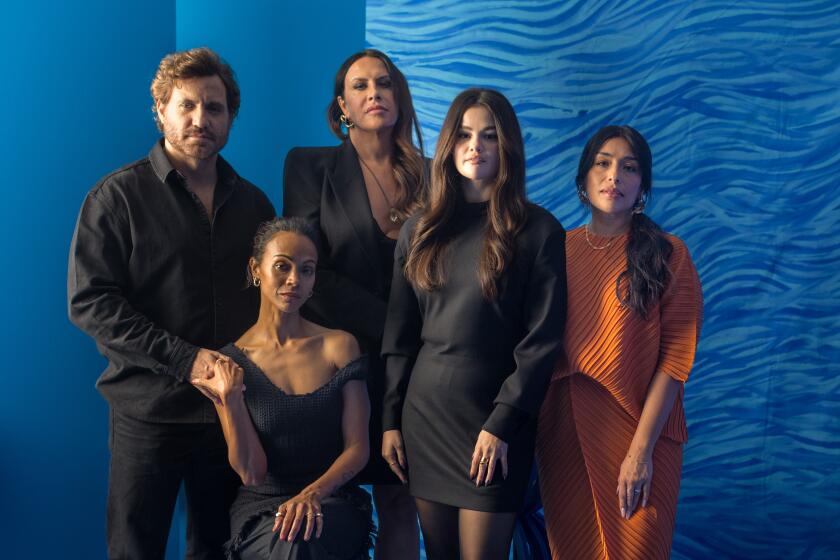On the set: Casting of ‘Last Airbender’ stirs controversy
Reporting from Philadelphia
By now, the movie industry has plenty of practice weathering the complaints of fans who object to the inevitable departures that accompany the adaptation of a pre-existing property to a big-screen franchise. But the concerns that surfaced as M. Night Shyamalan went into production on “The Last Airbender” were more serious than the usual nitpicking. Amid the kvetching about the shape and size of the facial scar sported by the film’s chief villain were accusations that Shyamalan had whitewashed the story, which was influenced by Asian art and mythology, by casting Caucasian actors in many leading roles.
Noah Ringer, a tween tae kwon do champion from Texas, was chosen for the role of Aang, a high-spirited boy who discovers that he is the last surviving member of the Air Nation; “Twlight’s” Jackson Rathbone and Nicola Peltz (“Deck the Halls”) were cast as his best friends, Water Nation siblings Sokka and Katara.
The “Airbender” outcry was not unusual — the controversy over Broadway’s “Miss Saigon” is but one of many forerunners. The source material for the Paramount Pictures film (which opens July 2, and if all goes well will have two succeeding installments) is “ Avatar: The Last Airbender,” an animated series that aired on Nickelodeon from 2005 to 2008. (The first word was dropped from the big-screen project for obvious reasons.)
Although creators Michael Dante DiMartino and Bryan Konietzko were heavily influenced by Asian martial arts lore and incorporated elements of Chinese and Tibetan cultures, the characters had no explicit race. But some Asian Americans saw the film’s casting as the latest in a string of insults from an industry in which it was once common for white actors to squint their eyes and spout fortune-cookie wisdom while Asian actors were confined to playing opium-den extras.
On the film’s Philadelphia set last summer, Shyamalan took issue with the idea that “The Last Airbender” presents a lily-white version of the cartoon’s universe. “Ultimately, this movie, and then the three movies, will be the most culturally diverse tentpole movies ever released, period,” he said. “So if I’m failing the bar, I’m not sure whose bar is set higher than this movie.” At the time when the criticisms first surfaced early last year, boy-band heartthrob Jesse McCartney was set to play the villainous Prince Zuko. But when he dropped out over conflicts with his touring schedule, the role was recast with “ Slumdog Millionaire’s” Dev Patel and the Fire Nation took on a darker hue. Iranian-born Shaun Toub was cast as Patel’s uncle and Maori actor Cliff Curtis as his father.
Toub, whose lengthy resume includes “ Iron Man” and “ Crash,” said that race-based casting would have come with its own problems. “If they would have put all Asians in a certain nation, I think then there would be people who come out and said, ‘Well, now you’re stereotyping, saying that anything that has to do with martial arts has to do with Asians and chop suey and all that.’ So it’s nice to mix it up and just do the unexpected.”
Doing the unexpected extends to tapping perhaps the most recognizable writer-director since Quentin Tarantino to film his first adaptation as well as the first movie to step away from his patented (and, some critics would say, tapped-out) thrillers.
“The long-form story was always really interesting to me, but the idea of going away for three years to write a long-form movie didn’t seem realistic, at least right now,” Shyamalan said. “One thing that’s very interesting is that, because it hasn’t been mine from the inception, I’ve had a little bit more perspective, so it isn’t as painful to adapt or change something. Just a hair more acceptance of the ability to do that is real healthy, and now I can bring that to the movies I write as well.”
Together with “Lord of the Rings” cinematographer Andrew Lesnie, Shyamalan worked to strike a balance between the extensive CGI demanded by the otherworldly setting of the story and a tactile reality conveyed through long takes and real fight scenes. (Patel, like Ringer, has been practicing martial arts since childhood.) His goal was to transfer the aesthetic and work ethics of his earlier films onto the much larger stage of a summer blockbuster, a task endorsed by producer Frank Marshall, who last worked with Shyamalan on 2002’s “Signs.”
“I think what he’s learned is how to take the ideas he has, which were small before, and realize them in a movie like this without losing the spirituality of the other movies,” Marshall said. “He’s been able to keep that tone and that feeling and not be overwhelmed by the process. There’s still a lot of humanity in what we’re doing and a lot of warmth and depth to the characters. It’s not overwhelmed by the fact that there’s a lot of special effects.”
More to Read
Only good movies
Get the Indie Focus newsletter, Mark Olsen's weekly guide to the world of cinema.
You may occasionally receive promotional content from the Los Angeles Times.










